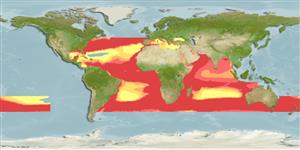Occur in oceanic and coastal waters (Ref. 26340). They are most common along surf beaches and rock headlands in clean, high energy waters, although adults can also be found in estuaries and into brackish water (Ref. 6492). Small fish may be found in shallow coastal waters at least 2 m depth (Ref. 9563), in schools pursuing and attacking small fishes (Ref. 9626). Adults are in loose groups, often attacking shoals of mullets or other fishes and destroying numbers apparently far in excess of feeding requirements (Ref. 9860). Feed on other fish (Ref. 5377), crustaceans and cephalopods (Ref. 47377). Associated with sharks and billfishes (Ref. 26340). Voracious and aggressive (Ref. 9626), reported to bite when handled. Migrate to warmer water during winter and to cooler water in summer (Ref. 9987). Popular game fish (Ref. 6638). Good food fish; marketed mostly fresh (Ref. 9860), but also dried or salted (Ref. 5284), and frozen (Ref. 9987).
出现于大洋性的与沿岸水域.(参考文献 26340) 他们是最常见的在清澈又生产力高的水域中沿着海滩浪花区与岩石海角, 虽然成鱼也能被发现于河口与进入半淡咸水之内.(参考文献 6492) 小鱼可能被发现于沿岸浅水区至少 2 公尺深 (参考文献 9563), 成群追逐和攻击小鱼.(参考文献 9626) 成鱼在松散的鱼群中, 时常攻击乌鱼或者其他的鱼的鱼群而且破坏超过显然远的摄取食物的需求的数字.(参考文献 9860) 吃其他的鱼 (参考文献 5377) ,甲壳动物与头足类动物。 (参考文献 47377) 伴随着鲨鱼与青旗鱼了。 (参考文献 26340) 一个狼吞虎咽与侵略性种 (参考文献 9626), 报告咬被触摸时。 在夏天在冬天期间对较热的水与对较冷的水域回游。 (参考文献 9987) 受欢迎的游钓鱼类.(参考文献 6638) 好食用鱼; 生鲜地 (参考文献 9860) 大部份在市场上销售, 也乾燥或盐腌 (参考文献 5284), 与冷冻.(参考文献 9987)
Preferred temperature (Ref.
115969): 8.4 - 27.5, mean 21.1 (based on 1273 cells).
Phylogenetic diversity index (Ref.
82804): PD
50 = 1.5000 [Uniqueness, from 0.5 = low to 2.0 = high].
Bayesian length-weight: a=0.01072 (0.00841 - 0.01366), b=2.97 (2.90 - 3.04), in cm Total Length, based on LWR estimates for this species (Ref.
93245).
营养阶层 (Ref.
69278): 4.5 ±0.3 se; based on diet studies.
回复力 (Ref.
120179): 中等的, 族群倍增时间最少 1.4 - 4.4年 (K=0.10-0.2; tm=2; tmax=9; Fec=1 million).
Prior r = 0.67, 95% CL = 0.44 - 1.01, Based on 7 stock assessments.
Fishing Vulnerability (Ref.
59153): Moderate vulnerability (42 of 100).
Climate Vulnerability (Ref.
125649): Moderate to high vulnerability (46 of 100).
